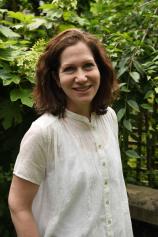A Door in the Earth
Review
A Door in the Earth
October 2019 will mark 18 years since the United States invaded Afghanistan in the wake of the 9/11 terrorist attacks. Unless one has participated personally in that war, or has a family member or friend who has, the conflict barely registers any longer in the thoughts of most Americans.
But if it achieves the wide readership it deserves, Amy Waldman’s second novel, A DOOR IN THE EARTH, might change that. Set in Afghanistan in mid-2009, it’s a troubling story of the moral ambiguity at the heart of the war and a painful depiction of the limits of idealism when it confronts the realities of a distant country’s culture, history and politics.
With her newly awarded Berkeley anthropology degree in hand, Afghan-American Parveen Shams sets off for a tiny village in the mountains of Afghanistan to help promote women’s health, especially for those who must endure the perilous process of childbirth. Born in Kabul, and an immigrant to the United States at age one, Parveen’s interest in her project is fired by a bestselling book written by an American physician, Gideon Crane. Crane had volunteered six years earlier in the village, one that’s been untouched by the war, and then established a charitable foundation to build a clinic following the death in childbirth of a woman named Fereshta.
"In addition to the complex ethical questions it raises, what makes A DOOR IN THE EARTH so rewarding is the care Waldman takes to make sure that the lives of the novel’s Afghani characters...are portrayed with the same honesty and empathy as Parveen’s."
Parveen takes up residence in the home of Waheed, Fereshta’s widower. Since her death, he’s taken two new wives --- Fereshta’s sister, Bina, and Shokoh, a much younger woman. Parveen quickly begins to compare Crane’s memoir with life on the ground, and the gap between the two soon widens into a chasm. Instead of a thriving clinic, for example, she finds an ill-equipped facility that is staffed only one day each week by a female doctor from Kabul, assisted by her teenage son.
As Parveen shares the stories of Crane’s book with the village’s women, that becomes only the first of many disturbing discoveries that erode her hero worship. The most consequential involves the discrepancies between his description of Fereshta’s death and those of eyewitnesses, but there are others that continue to reverberate long after his departure. Readers familiar with the controversy surrounding Greg Mortenson and his memoir, THREE CUPS OF TEA, will find echoes of that story here.
Parveen struggles to make the best of her situation, learning to provide rudimentary medical care, encouraging Shokoh’s attempts to write poetry and teaching Waheed’s son, Jamshid, to read. In all her efforts, she must confront the village’s rigid social structure, where the dai (traditional birth attendant) resists efforts to improve medical care, and the mullah plays an outsized role in matters that have nothing to do with religious life. And when her frustration with Crane reaches the breaking point, her well-meaning response produces a cascade of unintended consequences.
Life becomes infinitely more complicated when the American Lt. Col. Francis Trotter arrives in the village, determined to replace the “shit road to nowhere” that provides its only access with a modern road, a “gift from the American people to the village” and an act of “kind power.” It’s far from clear that the village leadership wants the road, but the Americans, whose benevolence is seasoned with a heavy dose of paternalism, remain undeterred. And as construction proceeds, the clash of cultures inevitably produces multiple tragedies.
Whether it’s Parveen’s frustrated idealism, or Trotter’s belief that he’s acting from altruistic motives, Waldman subtly reveals how our long engagement in Afghanistan hasn’t equipped us with wisdom that’s equal to our power. “The urge to intervene, a high of its own, was a hard habit to break,” Parveen reflects. “The salvation of others could become an addiction too.” And when it comes to our military and humanitarian commitments, “You wouldn’t try to cut your losses; you’d try to redeem them, even if that meant sending an arm after a leg, one death after another.”
Waldman served for three years as co-chief of the New York Times’s South Asia bureau, and her familiarity with the territory, including her sensitivity to the rugged beauty of Afghanistan’s landscape, is evident on every page. In addition to the complex ethical questions it raises, what makes A DOOR IN THE EARTH so rewarding is the care Waldman takes to make sure that the lives of the novel’s Afghani characters --- especially those of the women and their roles in this deeply patriarchal society --- are portrayed with the same honesty and empathy as Parveen’s.
Ten years after the events of A DOOR IN THE EARTH, the United States inches toward a resolution that will allow us to bring the last of our soldiers home, as we assure ourselves we’ve truly done more good than harm and hope our departure won’t cause the country to regress quickly to its condition before 9/11. Through Parveen, Amy Waldman offers a sadly realistic assessment of our predicament, one that’s been scarred by “years more of wastage and death, then an end that America’s leaders would pretend made sense of what had come before. The dragon’s tail of 9/11 swept back and forth, back and forth, devastating everything in its path.” That’s a bitter message, but one that’s more than justified, it seems, by the story that’s told in this devastating novel.
Reviewed by Harvey Freedenberg on September 6, 2019
A Door in the Earth
- Publication Date: October 6, 2020
- Genres: Fiction
- Paperback: 400 pages
- Publisher: Back Bay Books
- ISBN-10: 0316451568
- ISBN-13: 9780316451567




